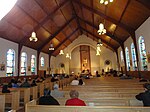Rockville, Connecticut
Census-designated places in ConnecticutCensus-designated places in Tolland County, ConnecticutFormer municipalities in ConnecticutHistoric districts in Tolland County, ConnecticutHistoric districts on the National Register of Historic Places in Connecticut ... and 8 more
NRHP infobox with nocatNational Register of Historic Places in Tolland County, ConnecticutPopulated places disestablished in 1965Rockville, ConnecticutUse mdy dates from July 2023Vernon, ConnecticutVillages in ConnecticutVillages in Tolland County, Connecticut

Rockville is a census-designated place and a village of the town of Vernon in Tolland County, Connecticut, United States. The village is part of the Capitol Planning Region. The population was 7,920 at the 2020 census. Incorporated as a city in 1889, it has been consolidated with the town of Vernon since 1965.
Excerpt from the Wikipedia article Rockville, Connecticut (License: CC BY-SA 3.0, Authors, Images).Rockville, Connecticut
West Main Street,
Geographical coordinates (GPS) Address Nearby Places Show on map
Geographical coordinates (GPS)
| Latitude | Longitude |
|---|---|
| N 41.8673 ° | E -72.4483 ° |
Address
West Main Street 13
06066
United States
Open on Google Maps









